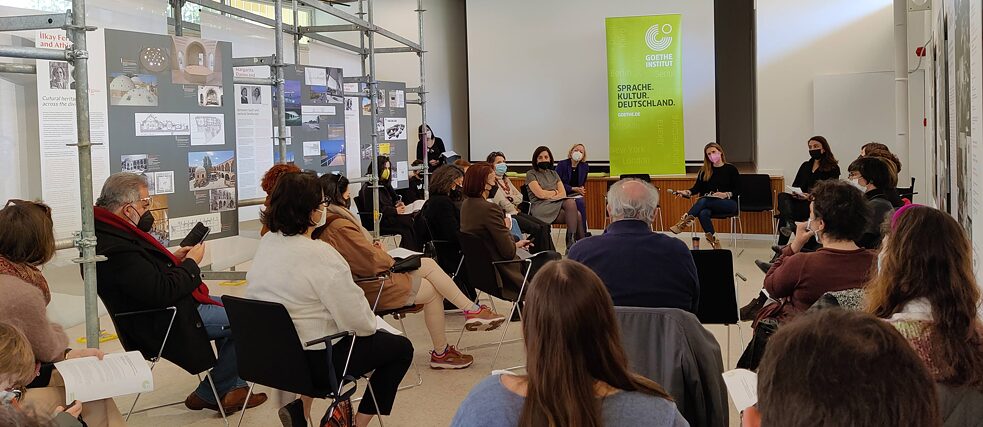Retrospective on a fishbowl discussion
Women in Architecture – the Cypriot context

The Goethe-Institut Cyprus is one of a number of organisations in Cyprus that has dealt and is dealing with the subject of gender and gender equality. From December 2021 until March 2022 it organised the exhibition “Frau Architekt”. The exhibition was developed by the Deutsches Architekturmuseum in Frankfurt and it was expanded by a chapter presenting women architects in Cyprus which was curated by Teresa Tourvas and Müge Riza. The presentation of Frau Architekt in Nicosia, constitutes the first dedicated exhibition celebrating the work of women architects from Cyprus.
Towards the end of the exhibition, which had been extended, a fishbowl discussion was organised. This happened to be only the second such discussion taking place in Cyprus, to the knowledge of all involved. The first one, titled "Women in architecture", had taken place not long before, specifically on 6 November 2021 at the SPEL and it was organised by the Cyprus Architects Association. Looking back at the fishbowl discussion organised at the Goethe-Institut Cyprus on 12 March 2022, many of the thoughts, experiences and questions shared still remain as relevant as ever. Some go beyond the subject of architecture and refer to the professional life and status of women in general.
We are sharing some individual thoughts and excerpts from the stories shared by some of the female architects that participated at the discussion.
“Participating in this exhibition raised for me certain questions. One question raised is, what are the challenges and not what are the obstacles? In the beginning I had to think twice if I am a female architect, a woman architect or if I am just an architect. I think this says a lot because it is the way that we define ourselves: we don’t define ourselves in a different way than male architects or we don’t confine with this group as something different. This is important because if we don’t define ourselves as something different then we don’t see the problems. So we don’t act. But at the same time, perhaps we have to start thinking that we are all same, that we have the same issues to work with.”
“You have to have a brave heart to be innovative as a woman architect. […] (For) most of the things that you want to do, you have to put humanism in the centre.”
“I had an experience in rural areas when I was doing my practice semester as an architectural student. So when I went to the site, all the workers were male. Then one of them asked me ‘I am wondering how you can read plans, why you can read plans as a woman’. Of course, I was very much shocked, because I told him ‘yes, this is my job, I have to read plans’. He then said ‘My wife cannot read plans...’ ” […] “Do I teach differently to my male colleagues? Or shall I teach differently?”
“I looked at the agency of design and how I can transform myself and the community I was in and my environment. When I started seeing design as agency, it all changed in me.”
“The question is whether being a woman architect has added a layer of complexity to our profession that male architects have not had to face. Our profession is a privileged one that affords a certain degree of equality. Now that said, other questions come to the fore: Do we perceive the design process in same way? Do we take inspiration from the same sources? Do we choose our information about our profession in the same way, on same values, same subjectivity? These are fine, small questions but they are worth asking.” […] “The presence of architecture, the presence of architects is something we need to look at seriously. Because if we say that we can overcome discrepancies between genders, then surely the discrepancies of what architecture does in underprivileged areas, where gender issues are prevalent, are something we should be looking into.” […] “In all my professional life, I have come across one electrician woman, one, and I think one decorator (painter). Why don’t more women interact with the construction side of the profession? Because it is also challenging and creative...”
“Our experiences are valuable and sharing this platform is very motivating. On exploring the boundaries it is indeed important to ask, what is the role of gender in expanding the boundaries of architecture? Is it possible that some of the questions we ask, as women, will be different than the questions of men?”
“It is interesting that we started this conversation by all [of us] almost denying that there is a problem or there is a difference. [...] Instead of trying to deny that there is a difference, [we have] to actually highlight it and choose the qualities that talk about the betterment of how we design. [...] This is only the second discussion about women architects in Cyprus. I think this is a really important moment, to step back and acknowledge that we have not been talking about this. And not having talked about this, it takes time to unwrap and really face any issues or any difficulties in admitting that there is something here to discuss.”